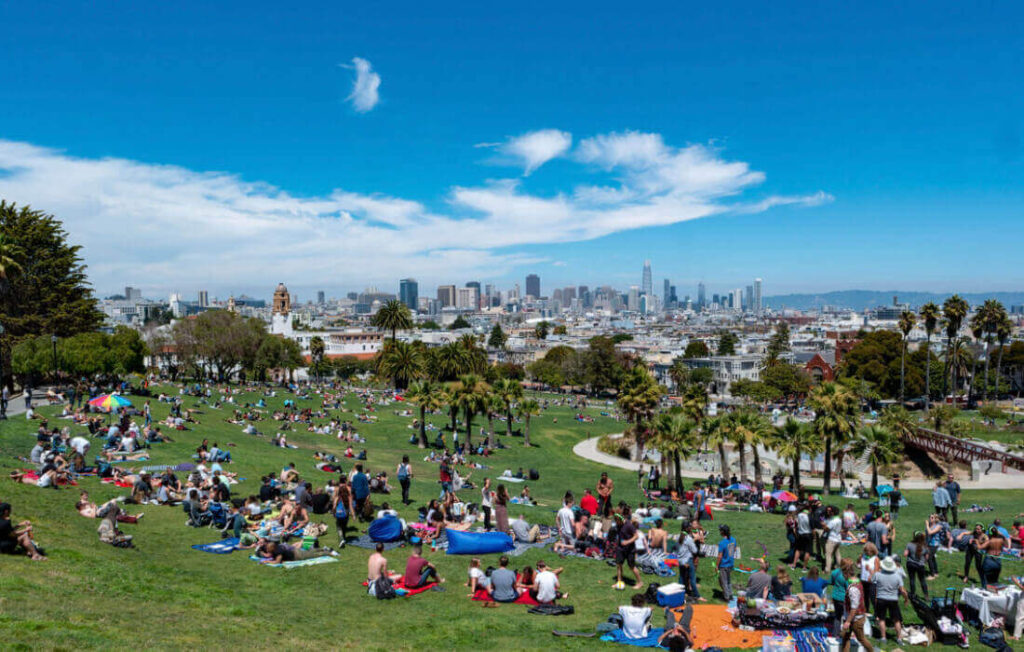Urban parks play a vital role in the social, economic, and physical well-being of cities and their residents. Regardless of the city or country in which they are located, these green spaces provide a natural escape for the millions upon millions of people who live and work in largely concrete city environments. It is essential that we do not take for granted the sheer importance of these natural reprieves.
In the United States, large-scale parks in cities throughout the country began to emerge in the mid-19th century, providing a space for visitors to decompress, relax, and—for a moment—step away from the busy urban lifestyle that can, at times, feel overwhelming. In addition to providing this natural space, these parks have also advanced democratic life, bringing people together across social, economic, and racial divides. In countries and spaces all over the world, parks are recognized as a powerful tool to improve urban life.
Public Health
Research shows that routine physical activity contributes to well-being and longevity, helping to prevent multiple chronic diseases like diabetes, heart disease, high blood pressure, depression, and cancer. But most Americans—adults and children—don’t meet the recommended daily guidelines. Parks are an ideal place for movement, providing the room and resources needed for running, walking, playing games and sports, and other active pursuits.
Environmental Value
A network of parks and open spaces that include protected natural lands, ecological reserves, wetlands, and other green areas is critical to providing healthy habitats for humans and wildlife in dense, urban areas. Every tree helps improve air quality by absorbing carbon dioxide and pollutants. And a park’s green infrastructure—not only trees, but garden vegetation and grassy areas—helps clean our water by capturing and filtering stormwater runoff.
Around the world, parks just like this have been in place for, in some cases, hundreds of years. The following three urban parks terrifically exemplify the environmental value of these spaces:
- Djurgarden in Stockholm, Sweden – This urban park has been a zoological garden since the 16th century and is located on its own island, referred to by locals as the “animal garden.” In addition to natural wildlife, this historical park houses trails, museums, and multiple palaces.
- Stanley Park in Vancouver, Canada – The first and largest park in the city of Vancouver, Stanley Park is more than 130 years old and is home to more than 500,000 trees.
- Mount Faber Park in Singapore – This is one of the only urban parks in the world with a rainforest ecosystem. The park’s purpose is two-fold: protecting native species and providing a setting for visitors to learn about these species and get closer to nature. The park emphasizes education, conservation, and the celebration of the local environment.
Economic Value
So many urban parks around the world offer more than just green space. While this is certainly critical, integrating commerce into these spaces can also be an amazing way to positively influence the local economy. Not to mention, cost-effective! A study of Long Island performed by the Trust for Public Land (TPL), “revealed that [New York]’s parks and open space provide a $2.74 billion annual economic benefit to local governments and taxpayers, and that conservation of Long Island’s parks and open space is eight times less costly than new residential development.”
Knowledge workers, workers in creative industries, families, and young people are increasingly choosing to reside in urban areas which offer amenities that contribute to an excellent quality of life. A well-designed, programmed, and maintained system for city parks is an essential component of any city’s strategy for attracting and retaining a strong workforce as well as spurring local investment.
- Hong Kong Park in Central, Hong Kong – A newer park to the region, Hong Kong Park houses one of the largest greenhouses in Southeast Asia in addition to a tea museum and aviary. The park blends a modern design with natural landscapes and resources that draw crowds from all over the region.
Historic & Cultural Value
In addition to preserving the natural environment in highly populated areas, urban parks are also essential for maintaining, and in many cases embodying, the cultural and historical significance of a city. Whether they’re home to museums that help preserve a city’s history or the land itself holds historical value, urban parks can be a great way to keep key historical figures, events, and eras in the memory of today’s residents.
The following urban parks are internationally renowned for their cultural and historical significance:
- Hamarikyu Gardens in Tokyo, Japan – Amid the sprawling city that’s home to nearly 14 million people, Hamarikyu Gardens houses beautiful green spaces that include 300-year-old trees planted by Shogun Ienobu.
- Park Guell in Barcelona, Spain – Famous for its colorful, scenic mosaics that have become a cultural icon of the city, Park Guell – once home to famous architect Antoni Gaudi – hosts a great number of Gaudi’s works as well as the house he originally lived in, which is now a museum in his honor. The well-known site is a point of Spanish pride and one that builds global awareness through the beautiful photographs taken here.
Community Value
Neighborhood parks can draw in and connect individuals of all ages and backgrounds who share a vision for the betterment of their surroundings and take pride in where they live. But most of today’s youth spend more time indoors than out, and in many communities, children simply do not have access to parks that are clean and safe. Parks are vital community assets where young people can grow and learn through recreation and interaction with nature, and where people of all ages can get involved in civic life.
- Central Park in New York City, USA – At just over 1.3 square miles, Central Park is the biggest green space in the city. It is home to playgrounds, monuments, museums, a zoo, theaters, skating rinks, boats, and more. The park is also a frequent location for large community events; everything from concerts to marathons to civic protests.
The gardens and natural greenery of urban parks are as much a part of history as the city that surrounds them – essential for human health, education, and culture. Yet, despite these benefits, public funding for their creation and long-term stewardship continues to decline. From private citizens to the businesses that make up a community, it’s time to champion high quality urban parks throughout the nation and make the case for greater park investment.
To become a champion for open spaces, check out EarthShare Common Ground, a new initiative promoting open space in Connecticut. Want to find open space initiatives in your area? Sign up for our Giving and Engagement Platform and search volunteer opportunities near you.




